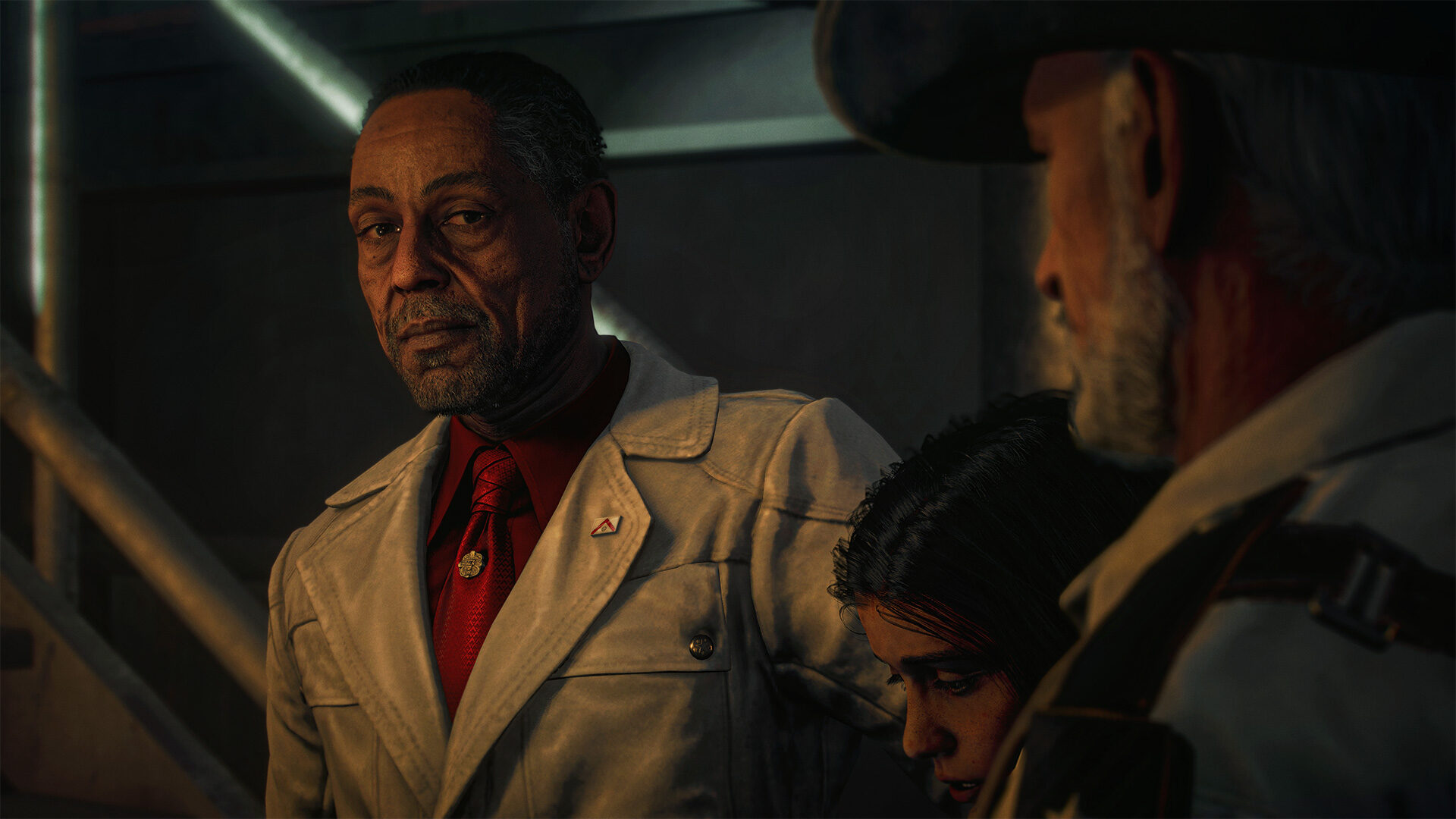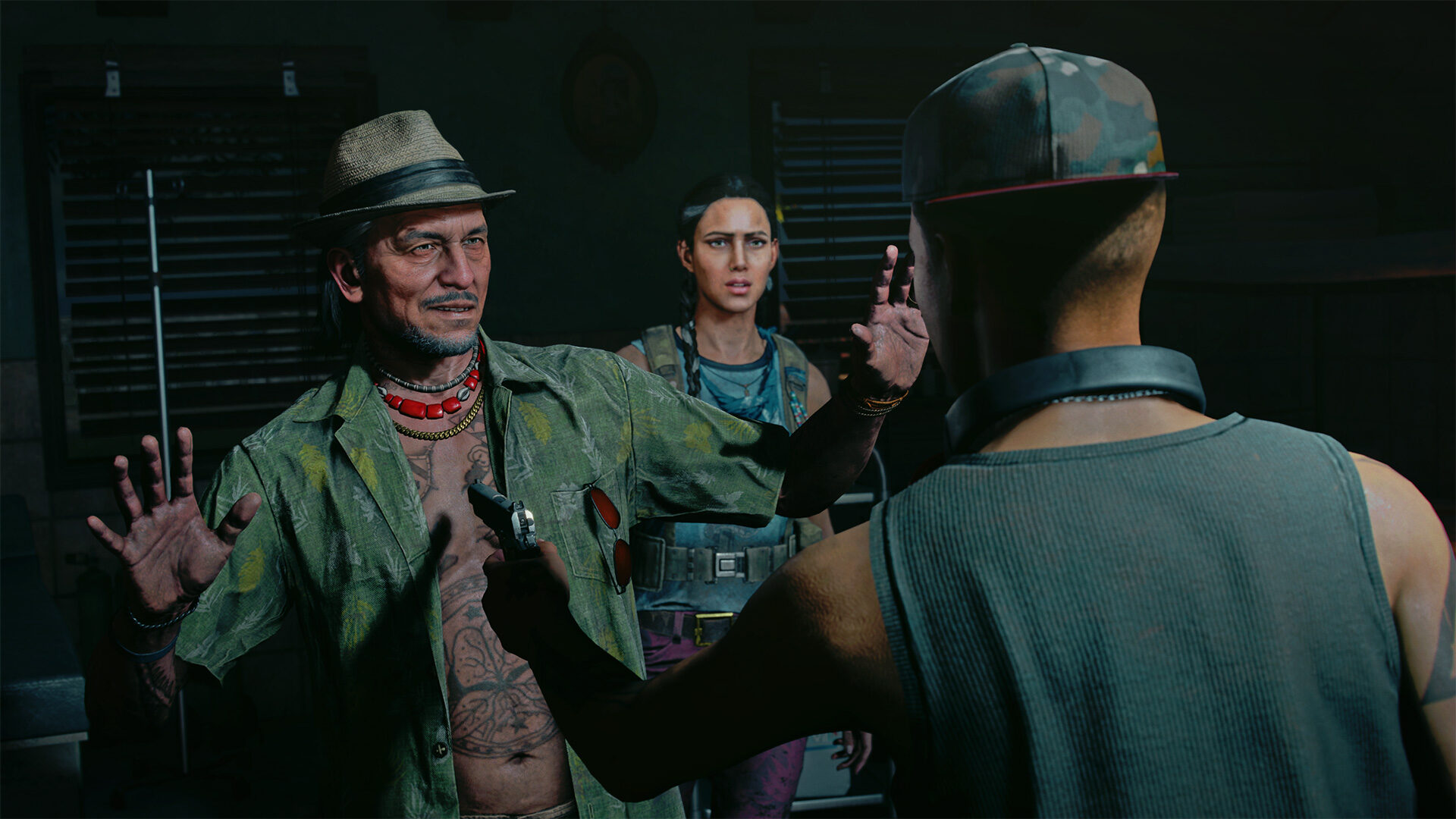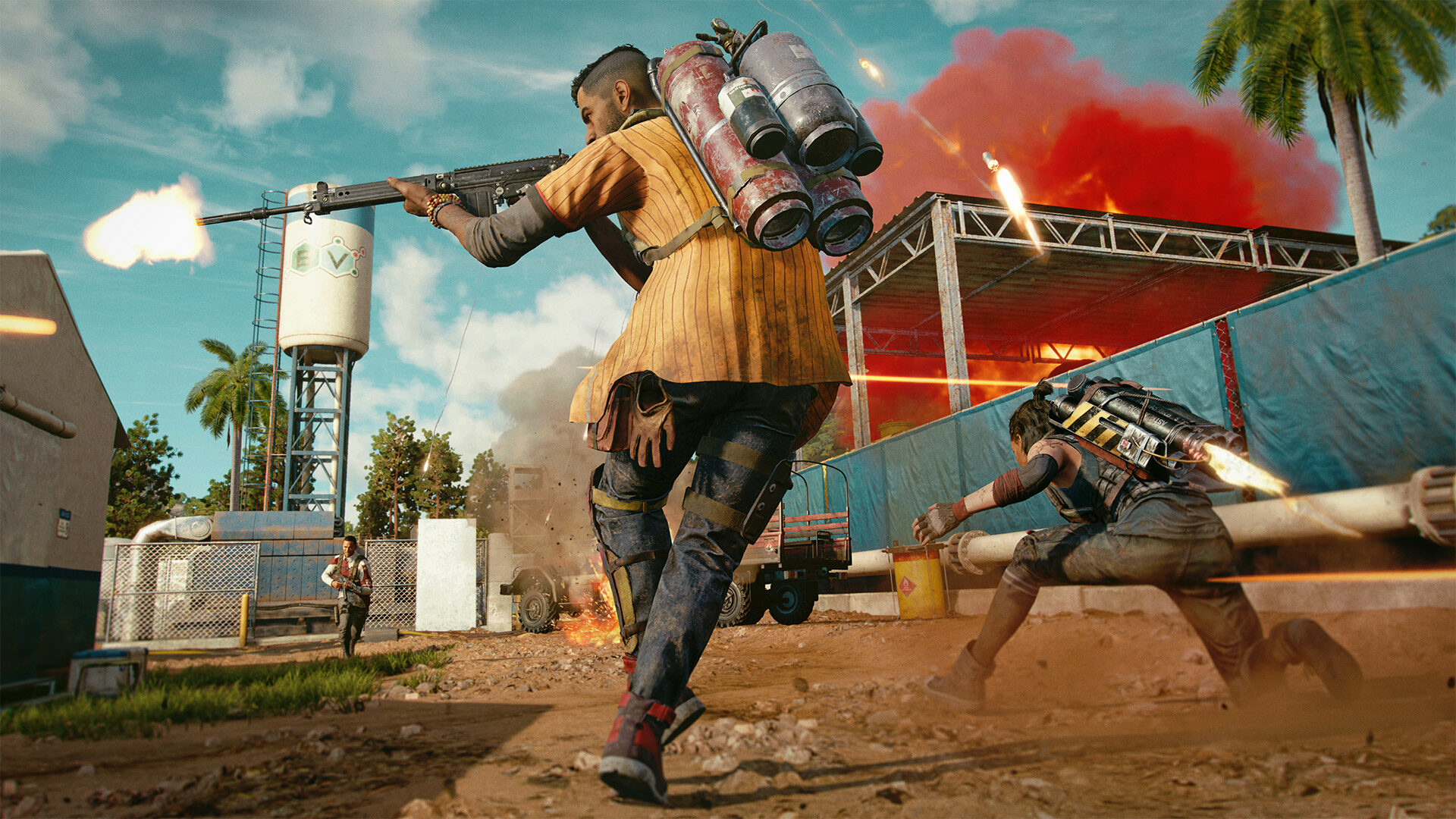I won’t go so far as to call the Far Cry series a “guilty pleasure,” but that’s what it feels like sometimes. Far Cry games never make my top-of-the-year lists, and the last few entries haven’t exactly pushed the series, let alone gaming in general, forward in any significant way, but I always look forward to playing them because they’re stupid, mindless fun.
Where Far Cry games do feel like a guilty pleasure is that the series has a very bad habit of wading in thematic waters without the capacity to fully explore them. There’s a common refrain that pops up every time a new Far Cry release looms on the horizon, and it’s that all Far Cry games are the same. Yes, Far Cry games are always first-person shooters with an action-adventure bent and large, open-world maps. Yes, structurally they all involve main story missions and side activities like taking over enemy bases and fortresses. You can say the same thing about most long-running series, but for some reason people seem to agree that Far Cry’s sins of repetition are more offensive than most.
But I don’t think that when people say “every Far Cry game is the same,” they’re talking about the gameplay alone. I think, maybe even subconsciously, Far Cry’s overarching sense of nihilism is what extracts this universal groan. Every Ubisoft-developed Far Cry game has, in one way or another, used political strife and tyranny as its norms—norms that the player must disrupt through violence—and the stories almost always end on the same grim, nihilistic note: No matter who’s at the top, the abuses of power will remain constant. It’s telling that the “good ending” in Far Cry 5 is the one in which a nuke destroys Montana.

The spoiled, bratty, privileged part of me loves how Far Cry lets me wade into the darker recesses of my own misanthropy. And it definitely loves blowing stuff up. But man, as I get older and see more of this nihilism have real-world ramifications, this edgelord outlook on human suffering becomes less appealing by the minute.
Now, another Far Cry game approaches, and after going hands-on with it for about five hours, I can safely say that, yes, Far Cry 6 sure is another Far Cry game, for better and for worse.
Far Cry 6 once again places players in an isolated part of the world that’s run by a tyrannical and yet charismatic psychopath in Antón Castillo, the dictatorial presidente of the fictional island country of Yara (which is, perhaps purposefully, also the name of a real town in Cuba, upon which Far Cry 6’s setting is based). This time, however, Ubisoft has cast (I might even say “typecast”) one of Hollywood’s most recognizable bad guys, Giancarlo Esposito, to play him.
Esposito is best known for playing cold and cunning antagonists in both Breaking Bad, The Mandalorian, and The Boys, and that’s pretty much exactly who he’s playing in Far Cry 6, too. Antón Castillo is a murderous, vengeful dictator whose idea of a father-son bonding moment is making his kid, Diego, execute a member of the Libertad, Yara’s resistance fighters. Of course, when Diego refuses, Antón then makes the young boy watch as one of his lieutenants ruthlessly beats the freedom fighter to death.
Castillo’s counterpart is Clara Garcia, the Libertad leader, who wants to depose Castillo by any means necessary. The first time your character, former soldier Dani Rojas (and no, they’re not the same character from Ted Lasso), meets Clara and asks for her help getting out of Yara, Clara calls her (or him, as Dani is customizable) a “pussy” and makes Dani work for her emigration by murdering hundreds of Castillo’s soldiers. “I am not fearless,” Clara says at one point, “but I will be feared,” notably talking in the singular. Like Far Cry 3’s Citra and Far Cry 4’s Golden Dawn leaders, Clara is your initial ally against the more obvious and pervasive evil that’s plaguing the land, but one gets a creeping sense, very early on, how things will turn out with Libertad if history is any indicator.
Despite all the telltale signs of Far Cry 6 following in its predecessors’ narrative footsteps, there are hints that Ubisoft is actually trying to tell a deeper, more rewarding tale about oppression and revolution this time around. The fact that we even see the cutscene I described above shows that the developers are willing to bend the franchise’s rules, since the main character isn’t present and we see it from a third-person perspective. There’s also the fact that Antón Castillo, despite how he enslaves and murders his own people, is actually trying to create and cultivate something that could save millions of lives in a cancer treatment called Viviro. And then there’s Diego, Castillo’s son and seemingly the game’s conscience, who possibly provides a third worldview beyond his father’s and Clara’s bloodsoaked fantasies.

I obviously can’t make a judgment on whether Diego will offer Far Cry 6’s writers an ideological out when it comes to the series’ traditional nihilism, especially because I only played for a few hours and the game is huge. The demo started me on Isla Santuario, a small island that’s just one piece of the archipelagic puzzle that is Yara. On its own, Isla Santuario will take at least a couple of hours to fully explore, and it is the beginning, tutorial area. It not only offers mission-critical locations like fortresses and tobacco farms, but there are plenty of smaller bases and blockades to claim in the name of Libertad, let alone puzzles to solve and collectibles to secure. Based on a look I got at the rest of the map, I would guess that Isla Santuario makes up somewhere around 10 percent of Yara’s complete landmass.
Obviously, bigger isn’t necessarily better (often it’s the opposite, in my experience), but Far Cry has never really struggled to fill space with interesting stuff. Still, it’s hard to tell from a five-hour demo whether Ubisoft will continue that tradition with Far Cry 6. What I can say is that Yara offers plenty of eye candy upon which players can feast. Returning the series to its tropical roots, Yara seems like a best-of showcasing everything one would want out of a Far Cry map. There are picturesque beaches and waterways, an extensive network of roadways, massive and dense jungles, open farmlands, and plenty of mountainous terrain to scale.
At times, the pure density of vegetation and the never-ending undulation of the map’s topography can seem like a lot to navigate, but Far Cry 6 expands upon its predecessor’s transportation options with even more air, land, and sea vehicles to pilot, including the return of helicopters and planes. However, one of the game’s most notable additions is also one of its most primitive: horses. At first glance, choosing a horse over one of the retro-looking cars, four-wheelers, or motorcycles might seem like a poor choice, but horses are the perfect transport for winding your way through Yara’s twisting, turning mountain trails. Even an ATV will struggle on the narrow dirt paths that you need to follow to reach some of Libertad’s secret hideaways, but a horse will get you there every time.
Tanks create new opportunities for navigating Yara, albeit a bit more explosively than trotting around on horseback. After stealing a tank from Castillo’s army on Isla Santuario, I felt unstoppable. Tanks are equipped with both explosive shells and a heavy machine gun, and you can make quick work of most of the Yaran armed forces with it. Even destroying other tanks didn’t take too much effort, as a couple of well-placed shots turned them into hunks of flaming metal. I suspect that tanks won’t always be the best option, especially in the more heavily guarded regions of the map where Castillo’s army have even more tanks of their own, not to mention attack choppers and stationary weapons like artillery. It did, however, allow me to make quick work of smaller outposts. Who needs stealth when you have a freaking tank? But if tanks seem to make the game too easy for you, you can still customize standard automobiles, adding features like shields to their fenders and machine gun turrets to their roofs.
The quickest way around Yara is by air, but Ubisoft has made sure that players won’t be able to simply HALO drop on top of Castillo’s head and assassinate him. Anti-air emplacements are found everywhere across Yara, so if you want to travel safely in a helicopter or plane, you will need to blow them up. Thankfully, the in-game map helpfully tells you which area each AA gun can cover, so there’s no guessing as to which one you need to take out if you’re trying to reach a specific area of the map from the skies. Plus, wingsuits are back, letting you fly under the radar, albeit for shorter distances than a plane or helicopter.
The most obvious changes that Ubisoft has made to Far Cry’s gameplay, however, is in the way that players will upgrade their version of Dani. Unlike past Far Cry games, which let players earn experience points that they could then spend to unlock skills, Far Cry 6 ties all of the character’s skills to whatever gear they’re wearing. Gear is hidden throughout Yara and unlocked after completing missions, and players can equip gear to Dani’s head, chest, wrist, and feet. You can mix and match what gear you equip, but each piece of gear is tied to a set that will maximize the perks for whatever play style you’re going for. The Parkour set, for example, includes perks that maximize your movement speed and stamina. Meanwhile, the Rioter set will help you defend yourself against Castillo’s armed thugs, giving you protection against different ammo types.
In theory, this is a positive change. Because they can swap gear from the menu whenever they want, players won’t be tied down to any specific playstyle by filling out a skill tree like in previous games. On the other hand, it also means that players will have fewer skills equipped at any given time, and they will have to spend a lot more time in menus, deciding what gear they want to wear to what mission. (In general, it also just kind of stinks whenever your character’s cosmetics are tied to specific gear perks and stats, although the only time you will see Dani will be in cutscenes and a few Libertad bases where the camera pulls out to a third-person perspective.)
It’s really hard to tell how this change will pan out over the course of playing through the entire game, considering I only spent about five hours with it so far and had limited gear options to choose from. But, from what I can tell, this change feels like a lateral move, rather than a full-on improvement. If anything, it feels like a way to get players to do a bunch of side quests they might otherwise not want to do, just so they can unlock a specific piece of gear they’ve been hunting. And if I want to be really cynical, I can also see Ubisoft using this gear system to sell microtransactions, though they haven’t yet talked about that aspect of the game. Still, this is Ubisoft we’re talking about, so microtransactions in a single-player experience are all but inevitable at this point.
Far Cry 6 also introduces the Supremo, a backpack that Dani wears that can unleash some kind of special attack or skill after a brief cooldown period. The Volta variation of the Supremo emits an EMP pulse that can knock over enemies and disable security systems and vehicles, while the Médico creates a cloud of gas around you that heals you and your co-op teammate. My favorite Supremo, however, is the Exterminador, which is basically a rocket salvo that you wear on your back. It launches a series of rockets that lock onto enemies and can get you out of a serious jam.
The Supremo is a fun new mechanic, even if I tended to forget it existed during my playthrough, but it didn’t fundamentally change the way I approached clearing outposts and other enemy checkpoints. If anything, it’s best used as a last resort. Beyond that, it feels slightly out of place in a game that posits the revolutionary forces as this rough and tumble organization with limited resources. Sure, the Supremo looks like it’s pieced together with scrap metal and yarn, but it’s also an incredible piece of technology that would make Far Cry heroes of games past envious. Where does a backpack that can heal you with magical healing gas or blast the surrounding area with an EMP fit within the scraping-by narrative?
The only place where Libertad’s scrappiness comes through, at least in gameplay, is in some of the modifications you can make to weapons using the workbench. You can, for example, build a homemade suppressor that will overheat if you fire too many shots at once. But there are also more professional suppressors you can unlock that don’t have that drawback. I’m sure that there will be a sense of progression, as you start to take back Yara from Castillo’s iron grip, that wasn’t present in the demo I experienced, since several later-game weapons and tools were unlocked for me to try out. This issue of the scrappy, resourceful Libertad not feeling so scrappy isn’t a total deal-breaker; it just feels slightly off, another indication that maybe Ubisoft is once again not taking its revolutionary setting seriously enough.

Beyond that, Far Cry 6’s gameplay is as fun as any other Far Cry game. Stealthily taking out an entire base is just as satisfying as it’s been in the past, and the weapons feel punchy and dramatic when you go in guns blazing. It is, after all, and as much as I hate to say it, another Far Cry game. If you’ve played any Far Cry games that have come out since 2008, you know what to expect when it comes to the action you’ll experience.
Usually, I’m excited to play another Far Cry game, even though I know that I will ultimately come away feeling like something was missing. But I can’t say I’m excited for Far Cry 6, even though I’m sure I will end up playing it for dozens of hours. Besides the sheer scale of the map, there was nothing about Far Cry 6 that totally blew me away, but there was nothing that disappointed me, either. After about five hours with the game, I mainly felt… ambivalent. Really, the only thing that feels different about this iteration compared to the rest of the series is that, in the end, I don’t feel anything at all about it one way or another.
But maybe that’s on me. After all, one thing the series has taught us is the definition of insanity, so I don’t know why I’d expect Far Cry to ever change. Besides, for some players, Far Cry 6 will be their first Far Cry, and it will blow their minds. For the rest of us, we’ll get another controversial shooter with overt political tones and no actual message. It will produce a flame war on Twitter, sell millions of copies, and eventually fade out of our memories until the next game comes around.
Images: Ubisoft

Michael Goroff has written and edited for EGM since 2017. You can follow him on Twitter @gogogoroff.